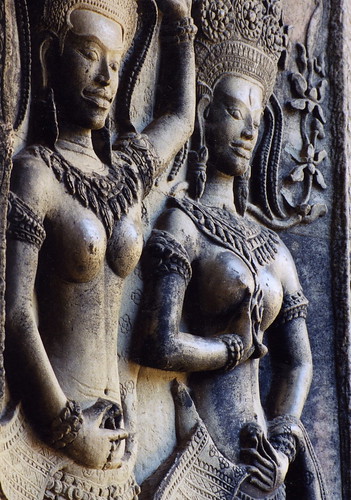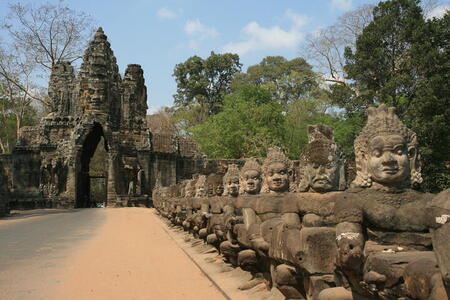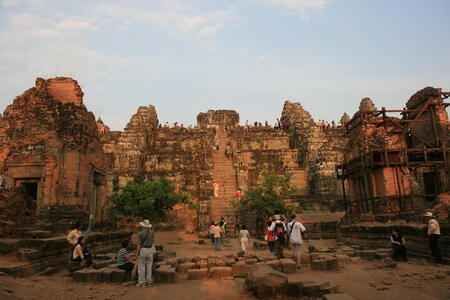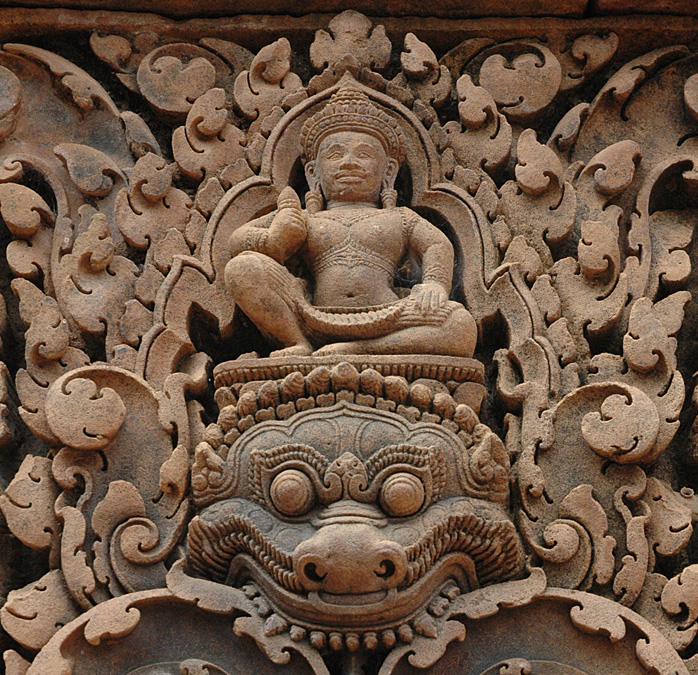
In order to truly understand the real Cambodia, one must visit one of the great archaeological sites in the world; the spiritual heart and identity of the Khmer people: the Angkor complex. Had any of the main temples, especially Angkor Wat been built anywhere else they would be as famous or as visited as the Taj Mahal, the Parthenon, the Coliseum or the Pyramids of Egypt. Angkor is without doubt one of the most breathtaking architectural masterpieces left standing in the world today. Without witnessing them at first hand it is impossible to gauge the enormity of task faced by the builders of the time and the fact they are so complete after all this time is further testament to the advanced construction techniques employed more than a millennium ago. Everything is built on a massive scale and one can only imagine the awe felt by ancient visitors as the civilization was at its peak. It is estimated that over one million people lived there making it the largest metropolis in its time. Witness the two hand dug reservoirs that served the civilization's rice growing agriculture: The Eastern Baray measures 7 km by 1.8 km and the Western Baray a staggering 8 km by 2.3 km.

Angkor Wat is the cultural home of the Khmer people and its form, in various guises has appeared and is still on the national flag. Had it been located in the Mediterranean basin it would have been one of the eight wonders of the world. The Lost City of Angkor was to remain undiscovered by Western archaeologists until the late 19th century and ever since has continued to amaze all who see it for the first time: neither words nor pictures do it justice. Angkor Wat is a legacy of the might that was once the Khmer Empire, a detailed history of which has been carved into the many walls of this fortified temple. The temple is accessible by a giant stone causeway across the hundred ninety meter moat, itself an incredible feat of engineering, to the west face of the Wat.
Angkor Thom

Angkor Thom was built by Cambodia's greatest builder, Jayavarman VII. This ten square kilometer city is enclosed by an eight meter high wall and encircled by a hundred meter moat said to have been inhabited by fierce crocodiles. There are five twenty meter high gates in the wall in each of the North, West and South walls and two in the East Wall. Access is via causeways over the moat that are flanked by the statues of fifty four Gods on the left and fifty four devils on the right, all seemingly engaged in a game of tug of war.
Bayon

Bayon is located in the geographical heart of Angkor Thom. The fifty four tower temple is a quite remarkable sight. Initially the temple seems to be a shapeless mass of grey and brown stone but as one approaches one realizes that each of the towers is in fact carved and there are over two hundred huge enigmatic faces of Avalokitesharva bearing down on you wherever you turn. The Bayon is easily the most popular sight after Angkor Wat and no visit is complete without a trip to see this amazing and unique temple.
Ta Prohm

Ta Prohm was built in the late 12th century by Jayavarman VII as a shrine to his mother and is another must for anyone coming to Siem Reap. As a monastery there were nearly three thousand priests here including eighteen high priests. Ta Prohm is unforgettable due to the massive trees that were left here intentionally by the archeologists working on the site. While clearing back the forest it was decided to leave them in place to serve as a reminder of how the original discovers found it and other temples. Many of the trees have grown around and through the remains, and soar high above the temple. This temple, along with those of the Bayon and Angkor Thom form the core of any visit to Siem Reap.
Phnom Bakheng

Phnom Bakheng served as the temple mountain of the first city of Angkor as opposed to the previous center of Roluos. The capital built on a lone hill offers panoramic views of Angkor Wat. Angkor Thom and the surrounding areas. It is best visited in the late afternoon for a spectacular sunset or in the early morning for sunrise over Angkor Wat.
Banteay Srei

Banteay Srei. While some of the temples are impressive because of their sheer size, Banteay Srei stands alone in the quality of its construction and decoration. Its pink sandstone wall are decorated with what some consider to be the best carving of all and in an amazing state of preservation. Built in 967 and dedicated to Brahma it is located twenty five kilometers North of Angkor Wat.
The Small Circuit takes in several of the major and minor temples in the area. Beginning at Angkor Wat and running for seventeen kilometers the circuit takes in the major elements of Angkor Thom, Ta Phrohm, and Banteay Kdei, and some of the minor but interesting temples such as the Baphoun, The Terrace of the Leper King, The Terrace of the Elephants, the Twelve Prasats, Spean Thma and Sras Srang before returning to Angkor Wat.
The twenty-six kilometer Grand Circuit is an extension on the little circuit but taking in Preah Khan, Preah Neak Pean to the Eastern Mebon and the various monuments like Ta Som, Preah Rup, before returnin to Angkor Wat and is highly recommended for anyone spending three or more days in the complex. The Big Circuit encompasses a good representation of the rich variety of architecture here.
Phnom Kulen is widely regarded as the birthplace of the ancient Khmer empire and is some forty eight kilometers from Siem Reap. This hilltop site has the country's largest reclining Buddha and it was here that the King Jayavarma II proclaimed independence from Java in 802 A.D. It has only just returned to government hands after the fall of the Khmer Rouge and is currently fairly inaccessible due to the poor state of the roads especially in the rainy season. Cutting through the area is the River of 1000 Lingas. Just five cm under the water's surface over 1000 small carvings are etched into the sandstone riverbed while further downstream larger blocks of stone are carved with Apsaras, Vishnu, and other figures. All the sandstone used in the construction of Angkor was quarried here.
Transportation
Tuk Tuk

Comfortable, economical and reliable - Prompt, professional and friendly service- Ride is pleasant, breezy and fun- Customize your own itinerary- Explore the temples at your own pace- Takes you anywhere you want to go- Flexible schedule that fits your needs- Space for lugguageA tuk tuk is a two person motorcycle trailer (moto-romauk) with a cover that protects you from the sun and rain.
Air
There are lots of flights from major south east asia city such as Vientien, Bangkok, Kuala Lumpur and Singapore.

No comments:
Post a Comment